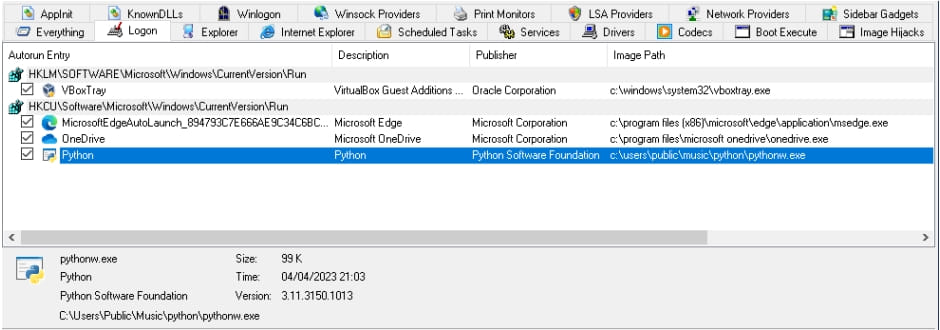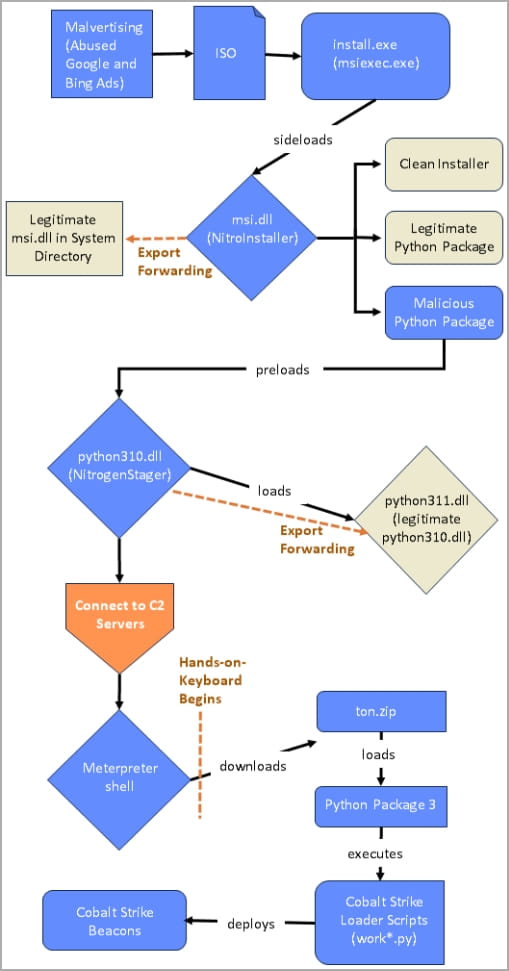New Nitrogen malware pushed via Google Ads for ransomware attacks

A new ‘Nitrogen’ initial access malware campaign uses Google and Bing search ads to promote fake software sites that infect unsuspecting users with Cobalt Strike and ransomware payloads.
The goal of the Nitrogen malware is to provide the threat actors initial access to corporate networks, allowing them to conduct data-theft, cyberespionage, and ultimately deploying the BlackCat/ALPHV ransomware.
Today, Sophos released a report on the Nitrogen campaign, detailing how it primarily targets technology and non-profit organizations in North America, impersonating popular software like AnyDesk, Cisco AnyConnect VPN, TreeSize Free, and WinSCP.
eSentire was the first to document the Nitrogen campaign in late June, while Trend Micro analyzed the post-compromise activity of WinSCP ads leading to BlackCat/ALPHV ransomware infections at the start of the month.
However, that report focused on the post-infection stage and lacked extensive IoCs (Indicators of Compromise) due to being based on a single response incident.
The Nitrogen malware campaign
The Nitrogen malware campaign starts with a person performing a Google or Bing search for various popular software applications.
The software seen as lures for the Nitrogen malware campaign includes:
- AnyDesk (remote desktop application)
- WinSCP (SFTP/FTP client for Windows)
- Cisco AnyConnect (VPN suite)
- TreeSize Free (disk-space calculator and manager)
Depending on the targeting criteria, the search engine will display an advertisement that promotes the searched-for software.
Clicking the link brings the visitor to compromised WordPress hosting pages that imitate the legitimate software download sites for the particular application.
Only visitors of specific geographic regions are redirected to the phishing sites, while direct hits onto the malicious URLs trigger a rick-rolling redirection to YouTube videos instead.

Source: Sophos
From those fake sites, users download trojanized ISO installers (“install.exe”), which contain and sideload a malicious DLL file (“msi.dll”).
The msi.dll is the installer for the Nitrogen initial access malware called internally “NitrogenInstaller,” which further installs the promised app to avoid suspicion and a malicious Python package.

Source: Sophos
The NitrogenInstaller also creates a registry run key named “Python” for persistence, pointing to a malicious binary (“pythonw.exe”) that runs every five minutes.

Source: Sophos
The Python component will execute “NitrogenStager” (“python.311.dll”), which is responsible for establishing communication with the threat actor’s C2 and launching a Meterpreter shell and Cobalt Strike Beacons onto the victim’s system.
In some cases observed by Sophos analysts, the attackers moved to hands-on activity once the Meterpreter script was executed on the target system, executing manual commands to retrieve additional ZIP files and Python 3 environments.
The latter is needed for executing Cobalt Strike in memory, as the NitrogenStager cannot run Python scripts.

Source: Sophos
Sophos says due to successfully detecting and stopping the observed Nitrogen attacks, it has not determined the threat actor’s goal, but the infection chain point to staging the compromised systems for ransomware deployment.
However, Trend Micro had previously reported that this attack chain led to the deployment of the BlackCat ransomware in at least one case.
This campaign is not the first time ransomware gangs abused search engine advertisements to gain initial access to corporate networks, with both the Royal and Clop ransomware operations using this tactic in the past.
Users are recommended to avoid clicking on “promoted” results in search engines when downloading software and instead only downloading from the developer’s official site.
Also, be wary of any downloads utilizing ISO files for software, as that is an uncommon method to distribute legitimate Windows software, which usually comes as an .exe or .zip archive.
Update 7/27 – A Google spokesperson has sent BleepingComputer the following statement:
We have strict policies that prohibit ads that distribute malicious software. Our teams detected the malware campaigns mentioned in the report prior to its publication.
We moved quickly to remove the ads that violated our policies and took appropriate action on the advertisers’ accounts.
A considerable amount of time and effort goes into maintaining this website, creating backend automation and creating new features and content for you to make actionable intelligence decisions. Everyone that supports the site helps enable new functionality.
If you like the site, please support us on “Patreon” or “Buy Me A Coffee” using the buttons below
To keep up to date follow us on the below channels.

